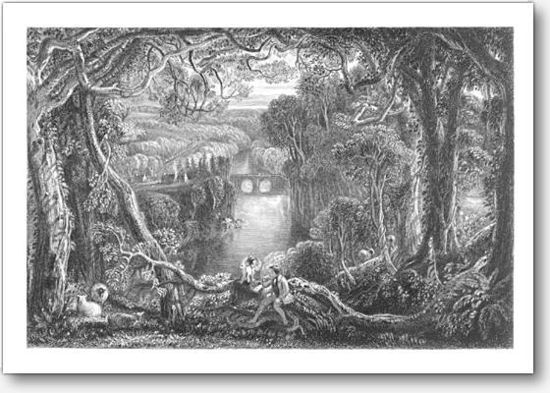Annotation:Braes of Ballochmyle (The): Difference between revisions
No edit summary |
No edit summary |
||
| (3 intermediate revisions by 2 users not shown) | |||
| Line 1: | Line 1: | ||
== | __NOABC__ | ||
<div class="noprint"> | |||
<p><font face="Century Gothic" size="4"> Back to [[{{BASEPAGENAME}}]] </font></p> | |||
</div> | |||
---- | ---- | ||
<p><font face=" | {{#lst:{{PAGENAME}}|abc}} | ||
'''BRAES OF BALLOCHMYLE, THE.''' Scottish, Air (whole time). G Major. Standard tuning (fiddle). AB. The name of a song written by Robert Burns in 1785, on the occasion of "the amiable and excellent family of Whitefoord's leaving Ballochmyle, when Sir John's | ---- | ||
<div style="page-break-before:always"></div> | |||
<p><font face="Century Gothic" size="3"> | |||
<div style="text-align: justify; direction: ltr; margin-bottom: 90px; margin-left: 70px; margin-right: 120px;"> | |||
<br> | |||
'''BRAES OF BALLOCHMYLE, THE.''' Scottish, Air (whole time). G Major. Standard tuning (fiddle). AB. The name of a song written by Robert Burns in 1785, on the occasion of "the amiable and excellent family of Whitefoord's leaving Ballochmyle," when the failure of Sir John's Ayrshire bank bankrupted him and obliged him to sell the estate. The 'Maria' named in the first stanza was said to be Mary Anne Whitefoord, Sir John's daughter, later Mrs. Cranstoun. The property was purchased by Claude Alexander, Esq., for whose sister Burns penned "[[Bonnie Lass o' Ballochmyle (The)]]." Burns's poem begins: | |||
[[File:ballochmyle.jpg|550px|thumb|left|A fanciful c. 1870's print of the Braes of Ballochmyle.]] | |||
<blockquote> | <blockquote> | ||
''The Catrine woods were yellow seen,''<br> | ''The Catrine woods were yellow seen,''<br> | ||
| Line 14: | Line 23: | ||
</blockquote> | </blockquote> | ||
The braes of Ballochmyle extend along the right or north bank of the Ayr, between the village of Catrine and Howford Bridge, about two miles from Burns's farm of Mossgiel. | The braes of Ballochmyle extend along the right or north bank of the Ayr, between the village of Catrine and Howford Bridge, about two miles from Burns's farm of Mossgiel. | ||
<br> | |||
<br> | |||
</div> | |||
</font></p> | </font></p> | ||
<p><font face=" | <div class="noprint"> | ||
''Source for notated version'': | <p><font face="Century Gothic" size="3"> '''Additional notes''' </font></p> | ||
<p><font face="Century Gothic" size="3"> | |||
<font color=red>''Source for notated version''</font>: - | |||
<br> | <br> | ||
<br> | <br> | ||
</font></p> | </font></p> | ||
<p><font face=" | <p><font face="Century Gothic" size="3"> | ||
''Printed sources'': Johnson ('''Scots Musical Museum, vol. 3'''), 1790; No. 276, p. 285. | <font color=red>''Printed sources''</font> : - J. Davie & Co. ('''Davie's Caledonian repository of the most favorite Scottish slow airs, marches, strathspeys, reels, jigs, hornpipes, &c., vol. 4'''), c. 1829; p. 12. Johnson ('''Scots Musical Museum, vol. 3'''), 1790; No. 276, p. 285. | ||
<br> | <br> | ||
<br> | <br> | ||
</font></p> | </font></p> | ||
<p><font face=" | <p><font face="Century Gothic" size="3"> | ||
''Recorded sources'': <font color=teal></font> | <font color=red>''Recorded sources'': </font> <font color=teal> - </font> | ||
</font></p> | </font></p> | ||
<br> | <br> | ||
---- | ---- | ||
== | <p><font face="Century Gothic" size="4"> Back to [[{{BASEPAGENAME}}]] </font></p> | ||
</div> | |||
__NOEDITSECTION__ | |||
__NOTITLE__ | |||
Latest revision as of 02:43, 10 October 2019
X:1 T:Braes of Ballochmyle, The C:Allan Masterton M:C L:1/8 R:Air B:Johnson - Scots Musical Museum vol. 3 (1790, No. 276) Z:AK/Fiddler's Companion K:Eb E|B2 AG e2 (dc)|(cB)(AG) G2 F G|(cd) ef ed cB|d2 Tc>B B2 zE| B2 AG c3B|AG FE F3G|(AB) (cd) e3 (d/c/)|B<G F>E E2 zE| e>f g>f e2 E>F|(G>F) (G>A) G3G|cd ef ed cB|G2 c>d !fermata!c2 (ec)| (B<G) (F>E) (c>B) (ce)|(c/B/A/G/) F E {G}F3G|A>G AB c>d!fermata!e c|(B<G) (F>E) E3||
BRAES OF BALLOCHMYLE, THE. Scottish, Air (whole time). G Major. Standard tuning (fiddle). AB. The name of a song written by Robert Burns in 1785, on the occasion of "the amiable and excellent family of Whitefoord's leaving Ballochmyle," when the failure of Sir John's Ayrshire bank bankrupted him and obliged him to sell the estate. The 'Maria' named in the first stanza was said to be Mary Anne Whitefoord, Sir John's daughter, later Mrs. Cranstoun. The property was purchased by Claude Alexander, Esq., for whose sister Burns penned "Bonnie Lass o' Ballochmyle (The)." Burns's poem begins:

The Catrine woods were yellow seen,
The flowers decay'd on Catrine lea,
Nae lav'rock sang on hillock green,
But nature sicken'd on the e'e.
Thro' faded groves Maria sang,
Hersel' in beauty's bloom the while;
And aye the wild-wood ehoes rang,
Fareweel the braes o Ballochmyle!
The braes of Ballochmyle extend along the right or north bank of the Ayr, between the village of Catrine and Howford Bridge, about two miles from Burns's farm of Mossgiel.
